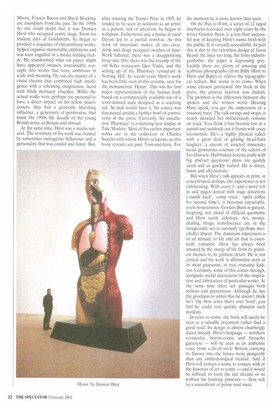Lost on the page
Richard Shone
ON THE WAY TO WORK by Damien Hirst and Gordon Burn Faber, £25, pp. 232, ISBN 0571202578 In almost every generation of British artists, there is one figure who enthralls their contemporaries. They are not always great artists but there is something in their attitude to life as mediated through their work that sets fire to their contemporaries' imaginations. Augustus John, Henry
Moore, Francis Bacon and David Hockney are exemplars from the past. In the 1990s no one could doubt that it was Damien Hirst who occupied centre stage. From his student days at Goldsmiths, he began to produce a sequence of extraordinary works, helped organise memorable exhibitions and was soon engulfed in a media feeding frenzy. He transformed what on paper might have appeared insanely unrealisable concepts into works that were ambitious in scale and meaning. He was the master of a visual theatre that combined high intelligence with a scheming imagination, laced with black mortuary chuckles. While the actual works were perhaps too personal to have a direct impact on his fellow practitioners, they had a generally liberating influence, a generosity of permission, that made the 1990s the decade of the young British artist, in Britain and abroad.
At the same time, Hirst was a media natural. The notoriety of his work was framed by sometimes outrageous behaviour and a personality that was candid and funny. But, after winning the Turner Prize in 1995, he tended to be seen in isolation as an artist: as a person, sick of attention, he began to withdraw. Fatherhood and a house in rural Devon led to a partial removal. As this book of interviews makes all too clear, drink and drugs occupied swathes of time. Work faltered; there was a disappointing foray into film; there was the revamp of the old Soho restaurant Quo Vadis, and the setting up of the Pharmacy restaurant in Notting Hill. In recent years Hirst's work has been little seen in this country, save for the monumental 'Hymn'. This was his first major representation of the human body based on a commercially available toy of a semi-skinned male designed as a teaching aid. As luck would have it, his source was discovered amidst a further howl of controversy in the press. Currently, his installation Pharmacy' is a stunning new display at Tate Modern. Most of his earlier important works are in the collection of Charles Saatchi with whom Hirst's relations, as this book reveals, are pure Tom-and-Jerry. For the moment he is more known than seen,
On the Way to Work, a series of 12 taped interviews recorded over eight years by the writer Gordon Burn, is a less than successful way of keeping Hirst's name fresh with the public. It is virtually unreadable. In part this is due to the relentless design of Jason Beard, the lines too long, the fonts indistinguishable, the paper a depressing grey. Luckily there are plenty of amusing and scabrous photographs (from Baby Hirst to Hirst and Baby) to relieve the typographical tedium. But worse is to come. When some extracts previewed this book in the press, the general reaction was disdain. The problem is the difference between the spoken and the written word. Hearing Hirst speak, you get the impression of a runaway train. The talk swings and sways, is nearly derailed but miraculously remains on track, You think it has become lost in a tunnel and suddenly out it bursts with crazy locomotion. He's a highly physical talker with a great deal of girning, head-back laughter, a stream of enacted innuendo, facial gymnastics courtesy of the school of Les Dawson. Half-baked notions jostle with big abstract questions; plans are quickly aired and as quickly buried. He is direct, funny and affectionate.
But when Hirst's talk appears in print, in concentrated dollops, the experience is not exhilarating. With every fand c-word left in and pages dotted with stage directions (stands back', 'camp voice', 'spills coffee for second time'), it becomes intractable, even monotonous. Gordon Burn is patient, forgiving, not afraid of difficult questions; and Hirst rarely sidesteps. Art, money. dealing, drugs, reminiscence are in the foreground; sex is curiously (perhaps mercifully) absent. The dominant impression is of an attitude to life and art that is essentially romantic. Hirst has always been amazed by the sweep of life from its grandest themes to its grittiest detail. He is not cynical and his work is affirmative even at its most gruesome, in true romantic fashion. Certainly, some of this comes through, alongside useful discussions of the inspiration and fabrication of particular works. At the same time there are passages both tedious and pretentious. Although he has the goodness to admit that he doesn't think he's 'the best artist that's ever lived', you feel he could very quickly abandon such modesty.
In years to come, the book will surely be seen as a valuable document rather than a good read. Its design is almost charmingly dated already. Hirst's language — northern vernacular, horror-comic and Groucho gutterese — will be seen as an authentic voice from a fin-dc-siècle Britain, carrying its flavour into the future more pungently than any anthropological treatise. And if Hirst will remain a name to conjure with in the histories of art to come — and it would be difficult to treat the last decade or so without his looming presence — here will be a sourcebook of prime read meat.























































 Previous page
Previous page